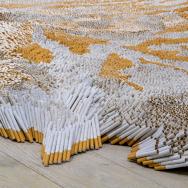A farming scene, drawn intricately with incense ash found in Buddhist temples. A dark metal pillar, acting as a canvas above a pool of water. And at first glance, a 36-foot-long tiger skin rug—an illusion created by hundreds of thousands of carefully placed cigarettes.
These are just a few of the artworks displayed in The Allure of Matter, hosted by the University of Chicago’s Smart Museum of Art and Wrightwood 659. Conceived by Prof. Wu Hung, the new exhibition marks a public introduction to “material art,” or caizhi yishu—a term he coined to distill a four-decade-long trend of artistic development in China.
One of the world’s leading experts in contemporary Chinese art, Wu uses the new concept to shift art scholarship from a historical, cultural or political framework to something more fundamental: The materiality of the art itself. From silk to human hair to melted plastic, The Allure of Matter highlights the ways that artists express themselves through a specific medium.
“Art is always part of politics, so to speak; that part is true,” said Wu, the Harrie A. Vanderstappen Distinguished Service Professor of Art History. “But I feel that artists—first, they want to create interesting works.”
The result is the Smart Museum’s largest exhibition ever, one that spreads 48 pieces between the UChicago campus and Wrightwood 659’s four-story building in Chicago’s Lincoln Park neighborhood.
Taking up the full gallery footprint of both sites, this joint show is the largest of four stops on a national tour—one which began last summer at the Los Angeles County Museum of Art and will continue later this year at the Seattle Art Museum and the Peabody Essex Museum in Salem, Massachusetts.
Wu advises even those who saw the LACMA exhibition, which closed last month, to visit The Allure of Matter in a different setting: “In Chicago’s spaces, the works will become more intimate.”
To incorporate nine additional works not shown in Los Angeles, Wu and co-curator Orianna Cacchione divided the exhibition according to the architecture of each space: The modernist white walls of the Smart Museum and the warm brick of Wrightwood 659, designed by Pritzker Prize winner Tadao Ando.
“Which work will look better here or there? That was our main criteria, to help us think about the relation of each piece to its place,” said Wu, who also prefaced the exhibition with a keynote address at UChicago’s U.S.-China Forum. “Each place has some wonderful works. If people are really interested, they shouldn’t miss either part.”
Wrightwood 659 will display the artwork through May 2, while the Smart will close its portion on May 3.
A fuller vision
Two decades ago, Wu partnered with the Smart Museum to debut Transience, one of the first large-scale exhibitions of contemporary Chinese art organized in the United States. He hadn’t yet crystallized “material art” as a concept, but similar ideas were present in that groundbreaking 1999 show.
The Allure of Matter represents a fuller realization of Wu’s vision—one that seeks not only to highlight the physical qualities of the material, but their spiritual resonance and cultural context.
Artists who appear in both Transience and The Allure of Matter include Xu Bing, a 1999 MacArthur Fellow, and gu wenda, renowned for his use of human hair. The Smart Museum currently features Xu’s 1st Class, named for the brand of cigarettes he uses to replicate a sprawling tiger skin rug. The piece is part of his Tobacco Project series, which explores the product’s social history and global impact.
For Cacchione, the Smart Museum’s curator of global contemporary art, the use of everyday materials can offer the public an easier way to engage with art—even if they might be unfamiliar with specific artists or art movements.
“I’ve gone to historical surveys of contemporary Chinese art, and I’ve absolutely loved those shows and I’ve completely geeked out on them,” she said. “But if you don’t know the history, sometimes those shows are really difficult to fully understand.”
Added Wu: “You see these individual works—works that can be a little strange at the beginning. Through these works, you discover the artists, and you discover their backgrounds. But they also offer us a focus to discover the artists’ creativity.”
A catalog produced for the exhibition includes artist profiles and essays from Wu and Cacchione, as well as Prof. Christine Mehring and Trevor Smith, a curator at the Peabody Essex Museum. Visitors also will have a chance to view videos that show how artists constructed their pieces—revealing the transformation of the materials in addition to their final presentation.
Asked if he had any personal favorites in the galleries, Wu demurred: There are so many great works, and some of the artists are longtime friends. But he did highlight Song Dong’s Traceless Stele, a metal pillar on which visitors can scrawl with calligraphy brushes—repurposing water as a form of temporary ink.
“It just evaporates, disappears,” Wu said. “It’s very smart. It’s a way of dealing with censorship, depending on how you want to read it. Or memory. Or even about the thought process. There are so many things you can think about in this piece.”
For Cacchione, that sort of wide-ranging, interpretive potential courses its way through the entire exhibition.
“I tend to think the best political art is the work that’s the most subtle,” she said. “Sometimes, that critique is the most biting.”
The Smart Museum of Art will host The Allure of Matter through May 3, and Wrightwood 659 will do so through May 2. Free admission is available at both sites, and Wrightwood 659 also offers paid reservations and tours. Visit theallureofmatter.org to learn more.

